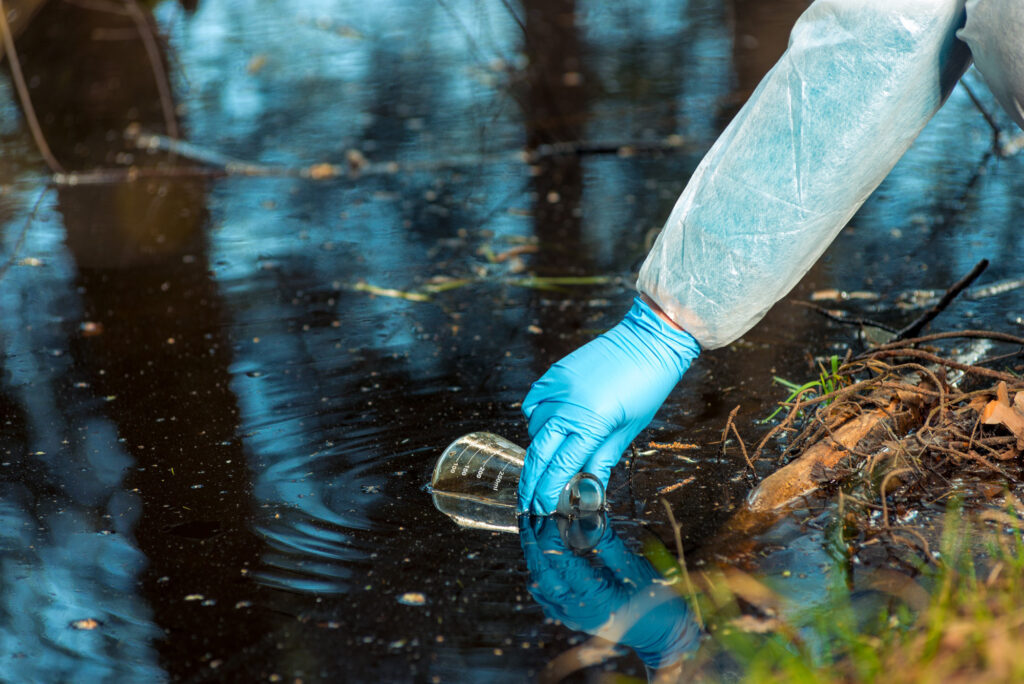Recent Kentucky News/Media Outlets have been sounding the alarm …

URGENT NEWS: Toxic “forever chemicals” have been found in Georgetown Municipal Water and Sewer Service and Kentucky-American Water systems in concentrations above the Environmental Protection Agency’s minimum reporting standards.
The EPA released data last week revealing GMWSS and Kentucky-American Water were among hundreds of water systems in the United States with PFAS. GMWSS services 35,714 customers while Kentucky American services 299,501 customers. All total over 46 million Americans are being provided drinking water with PFAS, according to the EPA. (Georgetown News-Graphic on 11/14/2023)
“The Kentucky Division of Water is ramping up to do a more comprehensive sampling of finished drinking water across the state. PFOA and PFOS are regulated separately. For the first quarter sampling GMWSS did not have any results above the 4.0 ppt. threshold for maximum limit, Azevedo said. However, results did indicate above the 1.3 ppt. which triggers quarterly monitoring, he said. GMWSS has conducted four quarters of samples for PFAS and FFOA, but only has results for the first two quarters.
“This is an extremely important issue facing water utilities across the nation. This is not just a GMWSS issue.”
Chase Azevedo, GMWSS general manager, See News-Graphic, Georgetown KY, 11/14/23
“In the latest round of testing for forever chemicals, the Kentucky Division of Water discovered high rates in two communities. Now, municipal leaders are working with state officials to try and fix it. In the latest round of data from 2023, the state found two places with PFAS levels above proposed federal standards, or maximum contaminant levels. The state’s first round of testing in 2019 found PFAS chemicals in about half the drinking water systems in Kentucky including Louisville.”
– Louisville Public Media (11/27/2023)
Kentucky Lantern, July 22, 2023 article
Per- and polyfluoroalkyl substances, commonly known as PFAS or “forever chemicals,” are in Kentucky’s rivers and lakes. The chemicals are in municipal water treatment plants. They’re accumulating inside Kentucky’s fish. “We have gathered a lot of information. None of the information that we’ve gathered has been or ever was intended to be used for regulatory purposes, We’re looking at it primarily from a public health standpoint, and primarily from a drinking water aspect here in the commonwealth.” – Tony Hatton, Commissioner of Kentucky Department of Environmental Protection
Now that we know this is not just a national issue, but a local Kentucky issue, let’s dive into understanding these “forever chemicals”, how they are harmful and how you can remove them from your home or business’ drinking water.
What are PFOAs, PFAs, PFOS?
Perfluoroalkyl and polyfluoralkyl substances, or PFAS, are a group of long-lasting, man-made chemicals that have been used in many consumer products and some manufacturing processes. Of the thousands of chemicals that make up PFAS, PFOS and PFOA are two of the most commonly used in the United States.
Perfluorooctanoic acid or PFOA and perfluorooctanesulfonic acid or PFOS are PFAS that were widely used in the manufacturing of many consumer products and industrial goods. Both PFOA and PFOS are now considered contaminants of concern by the US EPA. In fact, on June 15, 2022 the EPA updated their health advisory for PFOA and PFOS in water stating that negative health effects may occur when PFOS and PFOA are detected in water at concentration levels near zero.

How are these chemicals used?
Before the ban on the use of PFAS in the United States, these chemicals were used in a variety of household and industrial products. Products imported into the United States may still contain PFAS.
- Non-stick cooking tools
- Stain guards
- Some paint
- Firefighting Foam
- Some paper and cardboard goods
WHAT ARE THE RISKS OF PFAS EXPOSURE?

The biggest challenge with PFAS is that they take a very long time to break down. That is why they are also called, “Forever Chemicals.” PFAS, like PFOS and PFOA, can be found in water, soil, air, household items and even in the foods we eat. Because forever chemicals can exist in so many places, the likelihood of exposure is high. Our primary risks of exposure are through our water, household products like non-stick cookware and foods through either soil contamination or food packaging
How can PFAs in our water affect my health and my family’s health?
At this time, there is not enough information about the impact of PFAS on our health. PFAS research is too new to make judgments about the health effects linked to exposure; however, the CDC has conducted research into PFAS and PFOA. The CDC’s research includes a study that tested humans to see what percentage had been exposed to the chemicals. Their conclusion was that the majority of people tested had at least some exposure to the chemicals, meaning exposure is widespread in the United States.
According to the CDC, prolonged exposure to PFOA and PFOS can have adverse health affects including but not limited to:
- Growth and development challenges
- Reproduction difficulties
- Liver damage
Why are they considered “Forever Chemicals”?
According to the EPA, the PFOA and PFOS do not break down and can accumulate over time. With the permanence of PFOS and PFOA chemicals, removing them from a water supply at scale is tough and a real concern.
What are the current regulations for levels of PFAS in the water?
Where the danger lies, is that for now PFAS are considered emerging contaminants, so there is currently no regulation of the chemicals in water supplies. The EPA has released a health advisory to address them, but a health advisory is not a regulation and cannot be enforced. This means municipal water suppliers are not required to meet any standards.
What parts of the United States are PFAS testing positive for?
If you live in an area where a public health advisory has been issued, you should learn more about how to protect yourself from prolonged exposure to PFAS. If you are not sure if your community is affected, the Environment Working Group provides maps and information about potentially affected areas.
How can you determine if PFAS are in your municipal or private water supply?
Municipal Water Supply: If you have city water, contact your municipal water supplier and ask if your water is affected. You are entitled to a copy of the water quality report that details what contaminants may be in your water and more. You can also ask if they are treating the water for PFAS contamination.
Private Water Supply: If you have a private well, you are solely responsible for your home’s water quality. Have your water tested to find the appropriate treatment solution.
How can I remove PFAS, PFOS, PFO & FFOA in your home’s water?
We’ve talked enough about the issues, nationally and locally, and the harmful affects and potential risks. So now, let’s talk solutions!
To remove PFAS from the water in your home the best approach is to install an in-home water treatment system. There are three water treatment technologies that the EPA says are effective at reducing PFAS in drinking water – reverse osmosis, activated carbon filtration and ion exchange. Both the Kinetico K5 Drinking Water Station® and PFAS-POU Filtration System are able to reduce PFOS and PFOA in water.
K5 DRINKING WATER STATION®

The K5 is our best drinking water system and it is third-party certified by the Water Quality Association to NSF International’s ANSI Standard 58 for PFOS/PFOA removal.
- The K5 uses reverse osmosis as well as activated carbon filtration to produce contaminant-free water.
- Purefecta Virus/Bacteria Guard, which reduces greater than: 99.99% of viruses 99.99999% of bacteria 99.999% of protozoa/cysts 99% Contaminant Removal
- The K5 is certified by WQA to NSF/ANSI Standard 58 for PFOS/PFOA removal.
- The K5 significantly reduces more contaminants, like lead and VOCs, than any other drinking water system in its class.
PFAS-POU FILTRATION SYSTEM

Kinetico also offers the PFAS-POU Filtration System which is an ultrafiltration device that can be installed as a point-of-use or point-of-entry water filter. This water filtration device uses activated carbon filtration to remove contaminants from your water. The PFAS-POU filter is able to reduce contaminants in water like PFAS, lead, volatile organic compounds and chlorine. Features include:
- Quick-Change Cartridge
- Economical Operation
- Improves Taste and Odor
- Contaminant Reduction: The PFAS-POU Filter reduces contaminants in your water including PFOS/PFOA, Lead, VOCs and Chlorine.
GET YOUR WATER TESTED FOR PFAS
If you believe your water may be affected by PFAS or other contaminants, have your water tested. You can schedule a water test with your KarSare Water Systems – Kinetico water expert.







